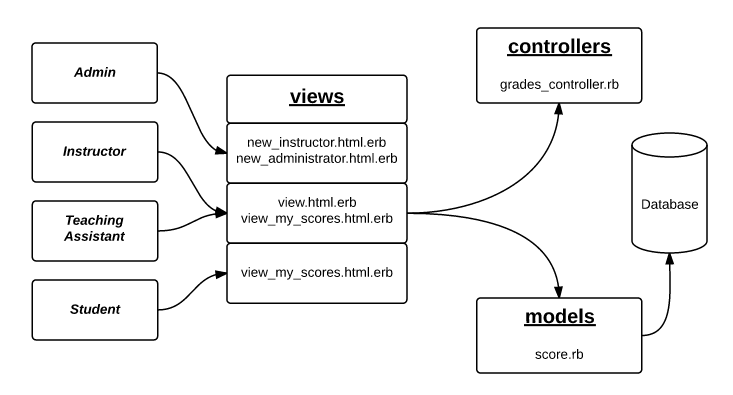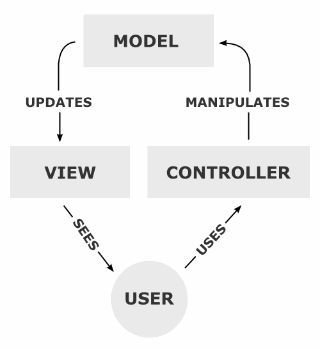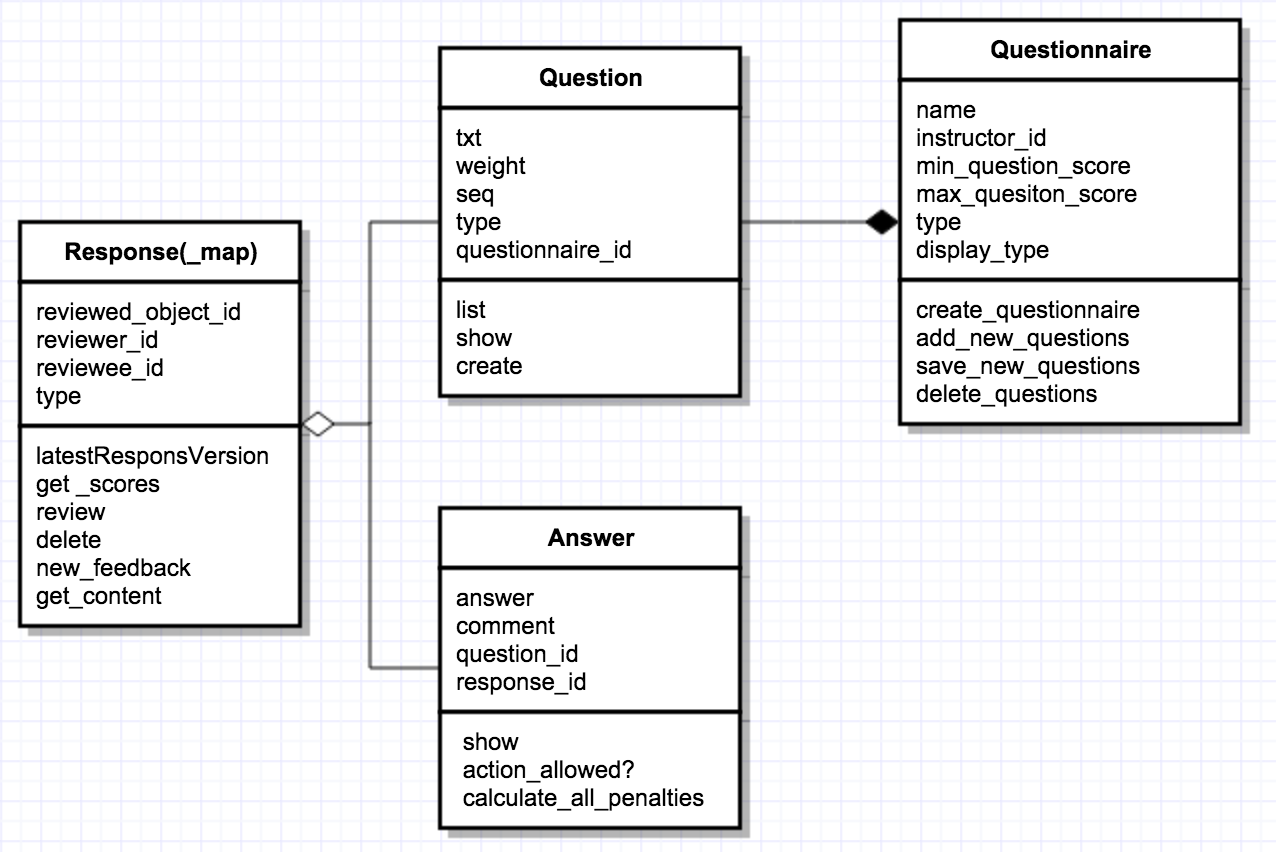CSC/ECE 517 Fall 2014/final E1472 gjfz: Difference between revisions
| Line 138: | Line 138: | ||
*Choose Assignment from multiple Assignments | *Choose Assignment from multiple Assignments | ||
*Select View Scores button from an Assignment menu | *Select View Scores button from an Assignment menu | ||
{| class="wikitable" | |||
|- | |||
! Name !! Actor !! other paticipants || precondition || primary sequence || Implementation Language | |||
|- | |||
| DMS || Production; Commercial; Active Enhancement || | |||
Production; | |||
C & C++; | |||
C++0x; | |||
ANSI,GCC, | |||
MSVC6, | |||
MS Studio 2005, | |||
SystemC; | |||
|| Tens of thousands of source files; Multilingual processing || Parallel implementation || PARLANSE | |||
|- | |||
| GCC || Production; Open Source; Active Enhancement || GCC; ANSI||One source plus includes || Fast, hand tuned || GCC C | |||
|- | |||
| EDG || Stable; Academic || Most C/C++ dialects || One Source file plus includes|| Fast hand tuned || C | |||
|- | |||
|OpenC++|| Stable; No preprocessor; Open Source || Most of ANSI C++; Limited template handling ||Single file plus includes || Unknown || C++ | |||
|- | |||
|Columbus || No preprocessor || ANSI C++ || Single plus includes || unknown || C++ | |||
|} | |||
== Design Pattern and Principle == | == Design Pattern and Principle == | ||
Revision as of 04:41, 19 November 2014
Design Document
E1472: Connect changes to score model with changes to score views
Introduction
Expertiza is a web application where students can submit and peer-review learning objects (articles, code, web sites, etc). It is used in select courses at NC State and by professors at several other colleges and universities. One of the Expertiza features is to report scores to both students and the instructor. The student can see the feedback from other students, such as the max score, the min score and the average score.
Requirements
A way to query db models to return scores, without UI changes
These methods report grades to students and instructors. The view method reports everyone’s grades to an instructor, and the view_my_scores method reports peer-review scores to a student. This code is very slow, due to many factors. Two of the most prominent are the fact that separate db queries are used for each rubric that has been filled out by anyone associated with the assignment; these queries are made sequentially while the HTML page is being written; and the fact that HTML for the whole page is generated, largely by controller methods, before anything is displayed.
UI changes for reporting scores
The GradesController class is responsible for displaying grades to students (via view_my_scores) and instructors or Teaching Assistant (via the view method). We will modify the Score class, and reduce the number of variables in order to remove code duplication and improve the loading speed.
What we need to do
- Remove the get_ and set_ accessor names; just use Ruby accessors.
- Change camel-case vs. underscores to match the Ruby convention.
- In grades/_participant.html.erb, don’t create local variables in the view; rather, create an object that has max, min, and avg fields for each kind of reviews. Try to avoid the need to check review type; instead, just pass the kind of review when referring to a max, min, or avg field and use polymorphism.
- Also, you shouldn’t have to check for the existence topic in the view; if it is null, a null string should just be returned.
- There are lots of calculations in the views, which should be moved to the model.
System Architecture

Views
Responsibility of view_my_scores html.erb is to display all the scores with respect to a participant and an assignment. For achieving optimal functionality, a good amount of refactoring had to be done in the views that were responsible for displaying the results to a user. A couple of problems were that:
- In the original expertiza application, all the reviews given to a user were listed one after another and this made finding a particular review very difficult.
- Also, when an admin clicked on view scores for an assignment, the time overhead to display the assignments was too high and this had to be taken care of.
Controllers
Apart from the template methods that are present in every controller class, the grades_controller specifically has two more methods:view and view_my_scores.
view
The 'view' method is responsible for handling the functionality of viewing the assignments of the whole class. Understandably, this is done through an admin/instructor's profile as only they have the privilege of viewing all participants' scores.
view_my_scores
The 'view_my_scores' method takes care of displaying the scores pertaining to an assignment to a single user.
In the controller methods, some amount of code pertaining to views too was initially coded. This code was refactored and made central to the views only so as to avoid duplication.
Models
Scores.rb has two methods which are responsible to compute scores for the participants based on assignments and courses.
Method get_total_scores() was making multiple sequential queries to the database to calculate scores. This method has been modified to retrieve data from a view. This view has been created in the database by migration “CreateMyViews”. Also, a new method ubmission_valid?' has been created to check whether the review is valid or not. This functionality was previously included in get_total_scores().
New model classes PartcipantScores.rb and AssignmentScores.rb have been created to retrieve the scores for participant and assignment respectively.
Use Case

The figure above mainly illustrates the process of viewing scores for different actors. The instructor and teaching assistant are able to view scores of all the team and could see the reviews of a selected team. Student actor can see his own scores and reviews.
| Actor | Description |
|---|---|
| Instructor | This actor is responsible for viewing scores and reviews of all the students(teams). |
| Teaching Assistant | This actor is responsible for viewing scores and reviews of all the students(teams). |
| Student | This actor is responsible for viewing scores and reviews of his own or of his team. |
Name: Student views his team score
Actor: Student
Other Participants: None
Precondition: At least team's score exists.
Primary Sequence:
- Log in to Expertiza
- Choose Assignment from multiple Assignments
- Select Your Scores button from an Assignment menu
Name: Student views his team's review by other students
Actor: Student
Other Participants: None
Precondition: At least team's score exists.
Primary Sequence:
- Log in to Expertiza
- Choose Assignment from multiple Assignments
- Select Your Scores button from an Assignment menu
- Select show_review in score page
Name: TA views teams' review
Actor: TA
Other Participants: None
Precondition: At least team's review exists.
Primary Sequence:
- Log in to Expertiza
- Choose Assignment from multiple Assignments
- Select Your Scores button from an Assignment menu
- Select show_review in score page
Name: Instructor or Teaching Assistant views the list of teams scores
Actor: Instructor or Teaching Assistant
Other Participants: None
Precondition: At least one team's score exists.
Primary Sequence:
- Log in to Expertiza
- Choose Assignment from multiple Assignments
- Select View Scores button from an Assignment menu
| Name | Actor | other paticipants | precondition | primary sequence | Implementation Language |
|---|---|---|---|---|---|
| DMS | Production; Commercial; Active Enhancement |
Production; C & C++; C++0x; ANSI,GCC, MSVC6, MS Studio 2005, SystemC; |
Tens of thousands of source files; Multilingual processing | Parallel implementation | PARLANSE |
| GCC | Production; Open Source; Active Enhancement | GCC; ANSI | One source plus includes | Fast, hand tuned | GCC C |
| EDG | Stable; Academic | Most C/C++ dialects | One Source file plus includes | Fast hand tuned | C |
| OpenC++ | Stable; No preprocessor; Open Source | Most of ANSI C++; Limited template handling | Single file plus includes | Unknown | C++ |
| Columbus | No preprocessor | ANSI C++ | Single plus includes | unknown | C++ |
Design Pattern and Principle
For this project, we will use the MVC design pattern. Model–view–controller (MVC) is a software architectural pattern for implementing user interfaces. It divides a given software application (such as web application) into three interconnected parts, so as to separate internal representations of information from the ways that information is presented to or accepted from the user.

The above diagram is an architecture of the MVC model with 3 components, and the interaction among them.
Components
The central component of MVC, the model, captures the behavior of the application in terms of its problem domain, independent of the user interface. The model directly manages the data, logic and rules of the application. A view can be any output representation of information, such as a chart or a diagram; multiple views of the same information are possible, such as a bar chart for management and a tabular view for accountants. The third part, the controller, accepts input and converts it to commands for the model or view.
Interactions
In addition to dividing the application into three kinds of components, the model–view–controller design defines the interactions between them.
- A controller can send commands to the model to update the model's state (e.g., editing a document). It can also send commands to its associated view to change the view's presentation of the model (e.g., by scrolling through a document).
- A model notifies its associated views and controllers when there has been a change in its state. This notification allows the views to produce updated output, and the controllers to change the available set of commands. In some cases an MVC implementation might instead be "passive," so that other components must poll the model for updates rather than being notified.
- A view requests information from the model that it uses to generate an output representation to the user.
Objected Oriented Design
The following class diagram shows a combination of new and existing classes along with the attributes and operations that are relevant to the implementation of this solution.

The RScore class stores the variables maximum,minimum, average review scores. Different type of reviews score is declared as subclass of RScore using ploymorphism. The type field is specified in their initialize method.